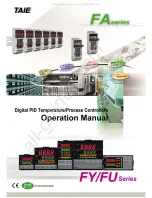
24
System Wiring
© 2011 Apollo Security Inc.
switching 2 amps at up to 24 volts DC. Connection of this internal relay is covered in Part 3.5.3 The reader
also has the capability of connecting external, high security relay modules (ADA-10/11) for control of the
electric lock as well as other outputs. Connection of these external relays is covered in the following sections.
Use of the internal relay provides for a simple, cost effective method for connection of the door strike with a
reduced level of security. If someone physically access the strike relay wiring, they may be able to release
the door. The external relays (ADA-10/11) are designed to eliminate this possible security breach.
Wiring between the strike power supply, strike relay (internal or external) and the electric lock should be of
sufficient gauge to prevent excessive voltage drop under all circumstances.
ALL ELECTRIC LOCKS MUST HAVE A SUPPRESSION CIRCUIT INSTALLED TO PREVENT EXCESSIVE
INTERFERENCE WITH OTHER SYSTEM COMPONENTS WHEN THE POWER IS REMOVED. SEE THE
FOLLOWING SECTION FOR INFORMATION ON SUPPRESSION INSTALLATION.
3.7.2
Strike Suppression Installation
Most electric locks consist of several components, one of which is usually a coil of wire that acts as an
electro-magnet to either release the door (Fail-Secure) or hold the door closed (Fail-Safe). This coil of wire
acts as a large inductor. When DC power is applied to a large inductor, energy is stored in the inductor.
When the circuit is broken (power is removed) this stored energy is converted to a very large voltage and
attempts to travel down the wires connected to the strike. IF SOME METHOD IS NOT UTILIZED TO
REDUCE OR SUPPRESS THIS VERY LARGE VOLTAGE, IT CAN CAUSE COMMUNICATIONS
PROBLEMS, PERMANENT DAMAGE TO THE STRIKE RELAY, AND PERMANENT DAMAGE TO OTHER
SYSTEM COMPONENTS!
The most common method of suppression used on DC power strikes is installation of a reverse biased diode
as close a possible to the strike itself. Any type of general purpose diode (1N4001 – 1N4006, etc.) will work
AC powered locks will not allow use of a diode for suppression. There are available suppressors for use with
AC powered locks called Metal Oxide Varistors (MOV’s). These are sometimes included with the lock. If you
wish to use AC powered strikes and a suitable suppressor is not supplied with the lock, you must contact the
manufacturer of the lock for information on obtaining a suitable suppressor. Connection of the suppressor
should follow the instructions provided with the lock.
3.7.3
Strike Wiring, Internal Relay
The AIM-4SL Reader Interface includes internal relays for door strike control for each of the four reader
inputs. This relay is capable of switching up to 24 volts at up to 2 amps. If the lock installed on the door
requires more than 2 amps to control, an external relay must be provided. The power that is provided to the
locking device (strike) through this relay may be connected to the same power supply that is providing power
the reader if the strike requires 12 or 24 volts DC. IF THE STRIKE REQUIRES A VOLTAGE OTHER THAN
12 OR 24 VOLTS DC OR ANY AC VOLTAGE, A SEPARATE POWER SUPPLY MUST BE USED.
Use of the internal strike relay allows for simple connection of the door strike without requiring installation of
external ADA-10/11 relay modules. This will result in reduced installation costs at the expense of increased
security. Use of the external, high-security, relay modules (ADA-10/11) will provide increased security on the
strike output.
The diagram below illustrates connection of a DC powered, Fail-Secure, door strike. This type of strike
requires power to release the door. The power will be supplied through the normally open (NO) relay contact
of the strike relay. No power will be provided to the strike until the reader activates the internal relay. The
reader will activate the relay as a result of a valid access request (card swipe, card swipe plus valid PIN,
valid PIN entry only, etc.). The reader will also permanently activate the strike relay if commanded by the
host software to be “unlocked”. The reader may also be configured to activate the relay if the exit pushbutton
is depressed. Some software systems may allow configuration of this feature (activate strike relay on exit
pushbutton) and others may not.
Содержание AIM-4SL
Страница 6: ...Part Introduction I ...
Страница 9: ...Part Hardware Layout II ...
Страница 19: ...Part System Wiring III ...
Страница 36: ...Part Troubleshooting IV ...
Страница 38: ...Part Specifications V ...
Страница 40: ...Part Supplemental Figures VI ...
Страница 41: ...36 Supplemental Figures 2011 Apollo Security Inc 6 Supplemental Figures ...
Страница 42: ...37 AIM 4SL Hardware Manual 2011 Apollo Security Inc ...
Страница 43: ...38 Supplemental Figures 2011 Apollo Security Inc ...
Страница 44: ...39 AIM 4SL Hardware Manual 2011 Apollo Security Inc ...
Страница 45: ...40 Supplemental Figures 2011 Apollo Security Inc ...
Страница 46: ...41 AIM 4SL Hardware Manual 2011 Apollo Security Inc ...
Страница 47: ...42 Supplemental Figures 2011 Apollo Security Inc ...
Страница 48: ...Part Table of Figures VII ...
Страница 50: ...Part Revision History VIII ...
















































